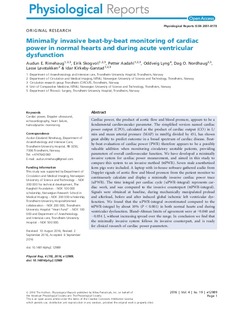| dc.contributor.author | Rimehaug, Audun Eskeland | |
| dc.contributor.author | Skogvoll, Eirik | |
| dc.contributor.author | Aadahl, Petter | |
| dc.contributor.author | Lyng, Oddveig | |
| dc.contributor.author | Nordhaug, Dag Ole | |
| dc.contributor.author | Løvstakken, Lasse | |
| dc.contributor.author | Kirkeby-Garstad, Idar | |
| dc.date.accessioned | 2016-10-18T06:15:54Z | |
| dc.date.accessioned | 2016-10-19T08:33:51Z | |
| dc.date.available | 2016-10-18T06:15:54Z | |
| dc.date.available | 2016-10-19T08:33:51Z | |
| dc.date.issued | 2016 | |
| dc.identifier.citation | Physiological Reports 2016 | nb_NO |
| dc.identifier.issn | 2051-817X | |
| dc.identifier.uri | http://hdl.handle.net/11250/2416264 | |
| dc.description.abstract | Cardiac power, the product of aortic flow and blood pressure, appears to be a fundamental cardiovascular parameter. The simplified version named cardiac power output (CPO), calculated as the product of cardiac output (CO) in L/min and mean arterial pressure (MAP) in mmHg divided by 451, has shown great ability to predict outcome in a broad spectrum of cardiac disease. Beat-by-beat evaluation of cardiac power (PWR) therefore appears to be a possibly valuable addition when monitoring circulatory unstable patients, providing parameters of overall cardiovascular function. We have developed a minimally invasive system for cardiac power measurement, and aimed in this study to compare this system to an invasive method (ttPWR). Seven male anesthetized farm pigs were included. A laptop with in-house software gathered audio from Doppler signals of aortic flow and blood pressure from the patient monitor to continuously calculate and display a minimally invasive cardiac power trace (uPWR). The time integral per cardiac cycle (uPWR-integral) represents cardiac work, and was compared to the invasive counterpart (ttPWR-integral). Signals were obtained at baseline, during mechanically manipulated preload and afterload, before and after induced global ischemic left ventricular dysfunction. We found that the uPWR-integral overestimated compared to the ttPWR-integral by about 10% (P < 0.001) in both normal hearts and during ventricular dysfunction. Bland-Altman limits of agreement were at +0.060 and -0.054 J, without increasing spread over the range. In conclusion we find that the minimally invasive system follows its invasive counterpart, and is ready for clinical research of cardiac power parameters. | nb_NO |
| dc.language.iso | eng | nb_NO |
| dc.publisher | Wiley Open Access | nb_NO |
| dc.rights | Navngivelse 3.0 Norge | * |
| dc.rights.uri | http://creativecommons.org/licenses/by/3.0/no/ | * |
| dc.title | Minimally invasive beat-by-beat monitoring of cardiac power in normal hearts and during acute ventricular dysfunction | nb_NO |
| dc.type | Journal article | nb_NO |
| dc.type | Peer reviewed | nb_NO |
| dc.date.updated | 2016-10-18T06:15:54Z | |
| dc.source.volume | 4 | nb_NO |
| dc.source.journal | Physiological Reports | nb_NO |
| dc.identifier.doi | 10.14814/phy2.12989 | |
| dc.identifier.cristin | 1392446 | |
| dc.description.localcode | (c) 2016 The Authors. Physiological Reports published by Wiley Periodicals, Inc. on behalf of the American Physiological Society and The Physiological Society. This is an open access article under the terms of the Creative Commons Attribution License which permits use, distribution and reproduction in any medium, provided the original work is properly cited. | nb_NO |

